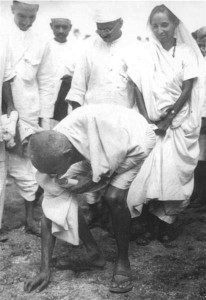The Spirit of Satyagraha
Attending the Gandhi Jayanti celebrations on October 2 at the NSW University Library lawn where a bust of Gandhiji has been recently installed brought back memories of a similar function I had attended in the US some years ago.
At that time in Manhattan Phillip Glass’s internationally acclaimed Opera “Satyagraha” was to open at the Lincoln Centre, and Helen, a dynamic lady came up with the idea of using the opportunity to get a “a true understanding” of Mohandas Gandhi’s life, his works and his life into the mainstream media, rather than just understand the concept of “Satyagraha” that he used to drive the British out of Colonial India as depicted in the Opera.
I had accompanied the India Abroad publisher, the late Gopal Raju. In conversation, Helen told Raju that a collaboration of leading New York cultural, arts, environmental, educational and spiritual institutions launched a multi faceted initiative to create a citywide dialogue on ”˜Satyagraha’, Gandhiji’s movement of social change in British colonial India.
As a student of History I was intrigued as the concern of Gandhi was not so much for national freedom as it was cultural in its sweep. Gandhi’s initiation into politics began with his fight against racial discrimination in South Africa. Since racial discrimination formed part of white man’s outlook, he was fighting a culture that justified that. Gandhiji wanted this culture replaced by a civilization that had its roots in Indian tradition of non violence.
The month long initiative of the New York Forum commenced with a gathering in Manhattan’s Union Square Park, the site of New York City’s Gandhi statue. Various peace and faith based organizations joined a silent walk to the Square.
April marks the anniversary of the 240 miles ”˜Salt March’ or ”˜Salt Satyagraha’ led by Gandhi in protest against the British Salt Tax and also the Anniversary of the assassination of Martin Luther King Jr, one of Gandhi’s most prominent American followers.
The Forum aimed to unite and inspire a new generation of Americans to apply Gandhi’s message to their own lives.
“Gandhi’s philosophy has just as much relevance today as it did 70 years ago. Instead of relying on others to change the world for us, we can understand that change for the outside comes from change on the inside ”“ this is the gist of sacred activism,” Helen said to the journalists.
Helen, as a young woman, travelled to India many times. She made her last trip after about 35 years. She visited Birla House, the site of Gandhiji’s assassination. When she came back she reread all the books she had since the 1960s on Gandhi. Her interest on Gandhi had a lot to do with her understanding of things in the US. She was trying to figure out a kind of way to integrate spiritual and political views and she felt that Gandhi had already offered a paradigm to integrate spiritual and political understanding which is really unparalleled in the modern world.
Phillip Glass’s Opera, the entire text of which is an adaptation from the Bhagavad Gita, depicts the early years of Gandhi in South Africa. Glass had been to India several times. He first got interested in Gandhi during a visit to Kalimpong in West Bengal in the mid 60’s, thanks to a chance meeting with a rug dealer on the street who showed him an old reel of Gandhi’s Salt March. He was inspired by Gandhi. He thought that the engaged life is the most powerful one ”“ and in that sense one truly becomes part of the community.
The Union Park event was followed by Satyagraha synapse with authors. They discussed if people are genetically predisposed to violence, or if there are there the other emotional forces at work that people are only now coming to understand.
Authors, psychologists and others exchanged ideas on the psychology of non-violence. A comparative discussion took place on the historical use of nonviolence strategies for peace in the US and Japan with a special focus on responses to the Iraq war.
The aim of the Forum is to try and contribute to a shift in our ”˜thinking ”˜and how one can better understand oneself’.
Short URL: https://indiandownunder.com.au/?p=158

